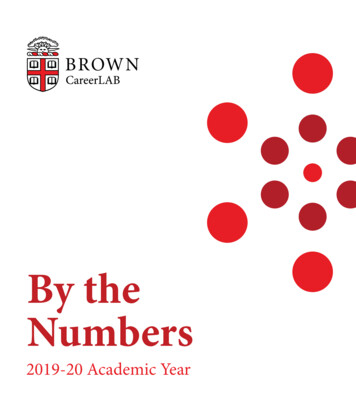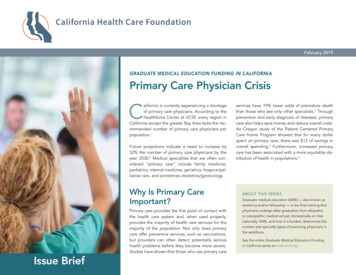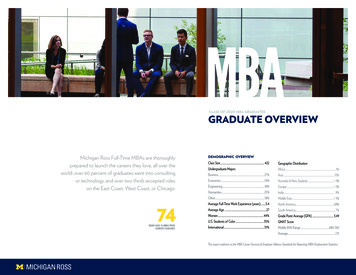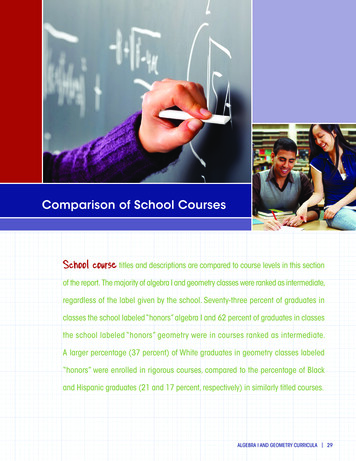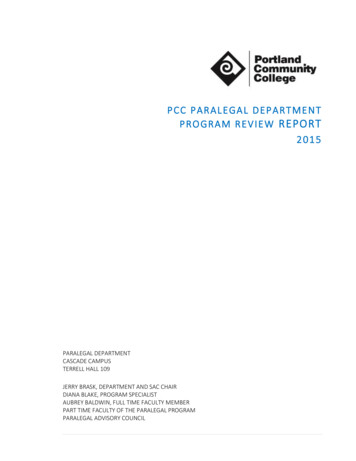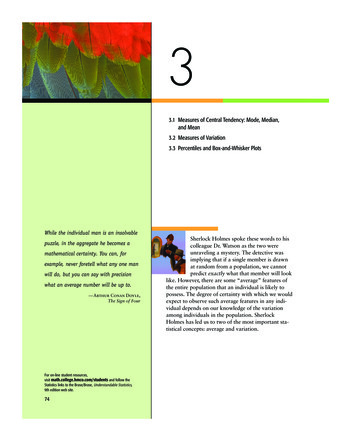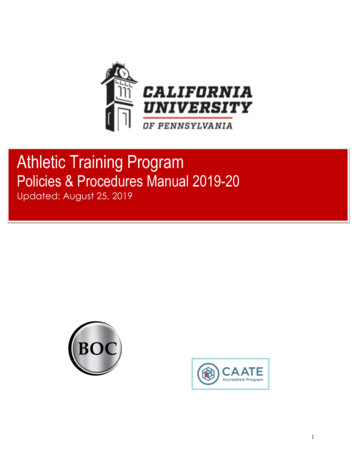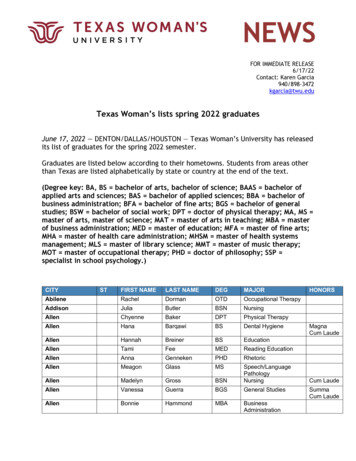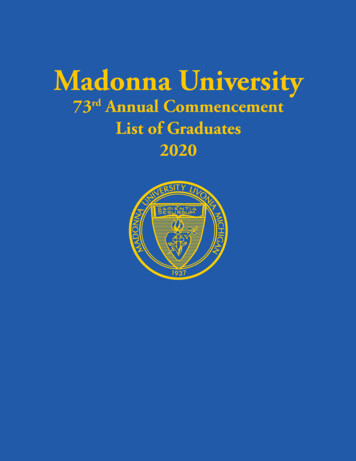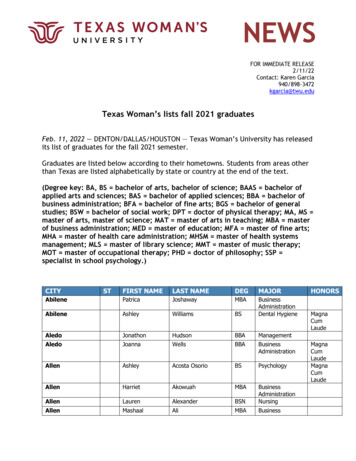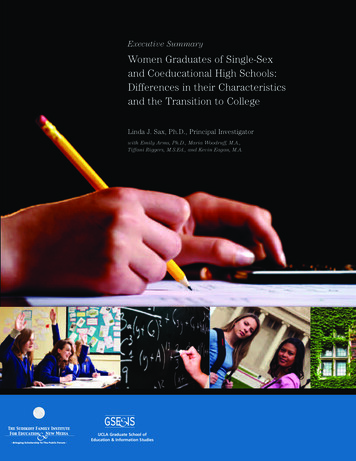
Transcription
Executive SummaryWomen Graduates of Single-Sexand Coeducational High Schools:Differences in their Characteristicsand the Transition to CollegeLinda J. Sax, Ph.D., Principal Investigatorwith Emily Arms, Ph.D., Maria Woodruff, M.A.,Tiffani Riggers, M.S.Ed., and Kevin Eagan, M.A.UCLA Graduate School ofEducation & Information Studies
Published by:The Sudikoff Family Institute for Education & New MediaUCLA Graduate School of Education & Information Studieswww.gseis.ucla.edu/sudikoff2341 Moore Hall, Box 951521Los Angeles, CA 90095-1521(310) 206-0513UCLA Graduate School ofEducation & Information StudiesEnhancing awareness of critical issues related to education and information studies, The Sudikoff Family Institute utilizes the popular press and other media to disseminate the work of UCLA Graduate School of Education& Information Studies scholars to policymakers, educators, and the general public. Sudikoff Fellows are choseneach year from the GSE&IS faculty to provide expertise and inform the public on a number of critical issues ineducation and new media. The Institute serves as a liaison between Fellows and the greater public, providingcommunications support and expertise.Associate Professor of Education Linda J. Sax, a 2007–08 Sudikoff Fellow, studies gender differences in collegestudent development, and women in particular, to determine how institutional characteristics, peer and facultyenvironments, and forms of student involvement may affect women and men college students differently.“Women Graduates of Single-Sex and Coeducational High Schools: Differences in their Characteristics and theTransition to College,” analyzes the effects of attending single-sex high schools on students’ transition tocollege. The Sudikoff Family Institute for Education & New Media at the UCLA Graduate School of Education &Information Studies made publication of this report possible.To download a copy of the full report, please visit: www.gseis.ucla.edu/sudikoff.
Women Graduates of Single-Sexand Coeducational High Schools:INTEREST IN SINGLE-SEX EDUCATIONhas been on the rise over the past twodecades, first in the private sector and more recently in the public sectorfollowing the U.S. Department of Education’s 2006 authorization of singlesex classes in public schools. As opportunities for public and private singlesex education have expanded, the debate surrounding this issue has becomemore heated. Sex-segregated schools and classrooms are viewed by many asa possible antidote to gender inequities that have been documentedthroughout all levels of education. Others, however, raise concerns thatsingle-sex settings run the risk of reinforcing sex-based stereotypes andexacerbating gender gaps in educational opportunity.The ongoing debate over single-sex education has led to greater demand for evidenceof its effectiveness. Researchers, educators, policymakers, and the public-at-large areanxious to know whether single-sex education makes a difference, and if so, how, andfor whom? Recent reviews of research on single-sex education have concluded that theevidence is mixed, due in large part to the difficulty of attributing differences betweensingle-sex and coeducational students specifically to the single-sex nature of theirexperience. All reviews emphasize the need for more research on single-sex education,especially that which examines a variety of outcomes, uses large and representativesamples, and relies on sophisticated methodologies that can disentangle the effects ofsingle-sex schooling from other confounding influences.W O M E N G R A D U AT E S O F S I N G L E - S E X A N D C O E D U C AT I O N A L H I G H S C H O O L S L I N D A J . S A X , P h DDifferences in theirCharacteristics and theTransition to College1
Commissioned by the National Coalition of Girls’ Schools (NCGS), this reportcontributes new data to the debate over single-sex education, with a focus exclusively onthe experience of female students from single-sex and coeducational high schools.Drawing from the renowned Freshman Survey, an annual, nationwide study of studentsentering their first year of college conducted by UCLA’s Higher Education ResearchInstitute, the study compares the backgrounds, behaviors, attitudes, and aspirations of6,552 women graduates of 225 private single-sex high schools with 14,684 women whograduated from 1,169 private coeducational high schools; the database also includesresponses of male students, though they are not examined in this report. The researchseparately considers female students from independent and Catholic school sectors, anddistinguishes the effects of single-sex schooling from the role played by other high schoolW O M E N G R A D U AT E S O F S I N G L E - S E X A N D C O E D U C AT I O N A L H I G H S C H O O L S L I N D A J . S A X , P h Dcharacteristics as well as the demographic backgrounds of females who attend all-girls’2schools. Due to its large, national sample and number of control variables, this currentstudy aims to make a notable contribution to the research on single-sex education.
Key FindingsDifferences between single-sex and coeducational alumnae were assessed in twoways. The first involved simple descriptive comparisons between these groupswithin independent and Catholic school sectors, and the second involved a multi-level analysis that accounted for differences in the single-sex and coeducational groups inDESCRIPTIVE RESULTSThe descriptive results reveal significant differencesbetween single-sex and coeducational alumnae.Though generally small, distinctions extend acrossmultiple categories, including self-confidence, political and social activism, life goals, and career orientation. Although future research will need to tell uswhether such differences are sustained throughoutcollege and beyond, at least at the point of collegeentry, most results are favorable to single-sex graduates. These include the following statistically significant differences:The descriptive resultsreveal significantdifferences betweensingle-sex and coeducational alumnae. Thoughgenerally small,distinctions extend acrossmultiple categories,including self-confidence,political and socialactivism, life goals, andcareer orientation.Greater Academic Engagement. Women graduates of single-sex schools exhibit higheracademic engagement than do their coeducational counterparts as measured by surveyquestions on time spent studying or doing homework, studying with other students,tutoring other students and talking with teachers outside of class:!Nearly two-thirds (62 percent) of women graduates of independent single-sexschools report spending 11 or more hours per week studying or doing homeworkin high school, compared to less than half (42 percent) of independent coeducational graduates. Study levels are comparatively lower among Catholic schoolalumnae, though the gap between single-sex and coeducational graduatesremains significant (35 percent for Catholic single-sex versus 24 percent forCatholic coeducational graduates).W O M E N G R A D U AT E S O F S I N G L E - S E X A N D C O E D U C AT I O N A L H I G H S C H O O L S L I N D A J . S A X , P h Dterms of their background characteristics and features of the high school they attended.3
!Students from single-sex schools are also more likely to engage in group study,with a full 53 percent of independent single-sex graduates reporting that theystudy with other students on a frequent basis, compared with 45 percent amongindependent coeducational graduates. Within Catholic schools, this difference is40 percent for Catholic single-sex graduates versus 34 percent of Catholic coeducational graduates.!Additional evidence of peer-based academic engagement is seen in the findingthat nearly two-thirds (65 percent) of women graduates of independent singlesex schools report frequently or occasionally tutoring other students in highschool, compared with 58 percent among women who attended independentW O M E N G R A D U AT E S O F S I N G L E - S E X A N D C O E D U C AT I O N A L H I G H S C H O O L S L I N D A J . S A X , P h Dcoeducational schools.4!Single-sex graduates also report more time talking with teachers outside ofclass, especially in the independent school sector, where 37 percent of single-sexgraduates reported spending three or more hours per week meeting withteachers apart from class, compared to 30 percent among women graduates ofindependent coeducational schools.Higher SAT Scores. Women who attended single-sexWomen who attendedsingle-sex schools tendedto ouscore their coeducational counterparts onthe SAT.schools tended to outscore their coeducational counterparts on the SAT. Mean SAT composite scores (Verbalplus Math) are 43 points higher for single-sex graduates within the independent school sector, and 28points higher for single-sex alumnae in the Catholicschool sector.Greater Interest in Graduate School. Women who attended single-sex schools are slightlymore likely than those who attended a coeducational school to say that they are going tocollege to prepare for graduate school (71 percent to 66 percent) and to choose a collegebecause its graduates are admitted to top graduate schools (45 percent to 41 percent).Higher Academic Self-Confidence. In addition to reporting higher levels of academicengagement, single-sex graduates — especially those from independent schools — tendto exhibit slightly higher levels of academic self-confidence:
81 percent of women graduates of independentsingle-sex schools rate themselves “aboveaverage” or in the “highest 10 percent” foracademic ability, compared to 75 percent ofwomen graduates of independent coeducational schools.!Nearly 60 percent of women graduates of independent single-sex schools rate themselves“above average” or in the “highest 10 percent”with regard to intellectual self-confidence,compared to 54 percent of their independent48 percent of womengraduates of independentsingle-sex schoolsrate thmselves “aboveaverage” or in the“highest 10 percent”for math ability,compared to 37 percentof women graduates ofindependent coeducational schools.coeducational school counterparts.!64 percent of women graduates of independent single-sex schools rate theirwriting ability “above average” or in the “highest 10 percent” compared to 59percent of independent coeducational school graduates.!45 percent of women graduates of independent single-sex schools rate theirpublic speaking ability “above average” or in the “highest 10 percent,” comparedto 39 percent of women graduates of independent coeducational schools.Higher Confidence in Mathematical Ability and Computer Skills. Graduates of single-sexschools also arrive at college with greater confidence in their mathematical andcomputer abilities:!The gap in math confidence is most pronounced in the independent schoolsector, where 48 percent of female graduates of independent single-sex schoolsrate their math ability “above average” or in the “highest 10 percent” comparedto 37 percent of independent coeducational graduates.!With regard to computer skills, 36 percent of women graduates of independentsingle-sex schools rate themselves in the highest categories, compared to 26percent of women graduates of independent coeducational schools. A similar gapin computer skill self-confidence exists for Catholic school alumnae, with 35percent of single-sex graduates rating their computer skills as above average orin the highest 10 percent compared to 27 percent of coeducational graduates.W O M E N G R A D U AT E S O F S I N G L E - S E X A N D C O E D U C AT I O N A L H I G H S C H O O L S L I N D A J . S A X , P h D!5
Greater Interest in Engineering Careers. Career aspirations are largely similar for graduates ofsingle-sex and coeducational schools, except when it comes to engineering. Single-sex schoolalumnae are more likely than their coeducational peers to state that they plan to become engineers. The single-sex versus coeducation gap is greatest in the independent schools, wheresingle-sex alumnae are three times more likely than women graduates of coeducationalschools to report that they intend to pursue a career in engineering (4.4 versus 1.4 percent).W O M E N G R A D U AT E S O F S I N G L E - S E X A N D C O E D U C AT I O N A L H I G H S C H O O L S L I N D A J . S A X , P h DGraduates of single-sexschools are more likelythan their coeducationalcounterparts to report thatthere is a very good chance6they will participate instudent clubs or groupswhile they are in college.Stronger Predisposition Towards Co-Curricular Engagement. Graduates of single-sex schools are more likelythan their coeducational counterparts to report thatthere is a very good chance they will participate instudent clubs or groups while they are in college. This isespecially true in the independent sector, where 70percent anticipate involvement in campus organizations, compared to 60 percent of coeducational alumnae.Greater Political Engagement. Female graduates ofsingle-sex schools are more likely than their coeducational counterparts to report that theyfrequently discuss politics in class and with friends. Political engagement is especiallystrong at independent schools, where 58 percent of independent single-sex graduatesreport that it is “very important” or “essential” for them to keep up to date with politicalaffairs, compared to 48 percent of women graduates of independent coeducational schools.Women at Catholic single-sex schools also are more likely to value political engagement(43 percent compared to 36 percent).RESULTS OF MULTILEVEL ANALYSESThough the descriptive analyses reveal more than one hundred statistically significantdifferences between women graduates of single-sex and coeducational schools, what ismost noteworthy is the number of differences that remain statistically significant whenaccounting for background differences between these two populations, including studentdemographics (e.g., race/ethnicity, family income, and parental education) as well ascharacteristics of the high schools they attended (e.g., enrollment and course offerings).Specifically, the second part of our analyses used hierarchical linear modeling (HLM)to reveal that all-girls’ schools, whether independent or Catholic-affiliated, producegraduates who enter college slightly more academically and politically engaged than
women from similar backgrounds who attended coeducational private schools. Girls’schools also produce alumnae who possess more confidence in their mathematical andcomputer skills, and are more likely to desire careers in engineering. Additionalbenefits are found specifically within the Catholic school sector, where attendance atan all-girls’ school enhances students’ scientific orientation (especially for Latinas),predicts higher SAT scores, and promotes an orientation towards college that is moreeducationally-motivated and less economically-motivated than is found among femalegraduates of Catholic coeducational schools.This study identifies several areas in whichsingle-sex education appears to producefavorable outcomes for female students, espe-cially in terms of their confidence, engagement, andaspirations, most notably in areas related to mathand science. Thus, while the benefits of single-sexeducation are fairly small, they tend to be in areasthat have historically favored men and thereforerepresent a potentially effective vehicle for mitigating longstanding gender gaps.Yet, the report also acknowledges that we cannot drawunilateral conclusions about single-sex education, asThe study points the waytoward an importantresearch agenda on thistopic: How and why dosingle-sex schools producepositive outcomes andwhich conditions couldbe transferred tocoeducational schools?Do the benefits ofsingle-sex educationpersist throughoutcollege and beyond?such determinations depend on which populations arestudied, which student and school characteristics are considered, and which outcomes areexamined. Thus, the study points the way towards an important research agenda on thistopic: How and why do single-sex schools produce positive outcomes and which conditionscould be transferred to coeducational schools? Which types of students benefit most fromsingle-sex education? Do the benefits of single-sex education persist throughout college andbeyond? In addition, how do the effects of single-sex education compare for males versusfemales? Attention to these questions using carefully designed and executed studies willadd vital context to the ongoing debate regarding public and private single-sex schooling.To download a copy of the full report, please visit: www.gseis.ucla.edu/sudikoff.W O M E N G R A D U AT E S O F S I N G L E - S E X A N D C O E D U C AT I O N A L H I G H S C H O O L S L I N D A J . S A X , P h DConclusions7
AcknowledgmentsAnumber of individuals and organizations were instrumental in making thisreport possible. The Higher Education Research Institute at UCLA providedthe student data that were essential in conducting the research. We areindebted to the graduate students who worked on early phases of the project, especially Jennifer Curley Mallen, Julie Park, Casey Eznekier Shapiro, and Hanna SongSpinosa. Their efforts were instrumental in crafting the student databases, codingdata for thousands of high schools, and conducting preliminary analyses that servedW O M E N G R A D U AT E S O F S I N G L E - S E X A N D C O E D U C AT I O N A L H I G H S C H O O L S L I N D A J . S A X , P h Das a framework for the present study. Our appreciation also extends to Professor8James Catterall of UCLA and Professor Amanda Datnow of UC San Diego, whoprovided constructive and insightful feedback on the draft report. We also thank DeanAimée Dorr, Kathy Wyer, and the Sudikoff Family Institute for Education & NewMedia at UCLA’s Graduate School of Education & Information Studies for providingsupport and resources for the dissemination of this report. Finally, we are grateful tothe National Coalition of Girls’ Schools, who provided financial support for the development of this report and who have demonstrated a commitment to supporting qualityresearch on single-sex education.
ABOUT THE AUTHORLinda J. Sax is Associate Professor of Higher Education in the Graduate School of Education & Information Studiesat UCLA, where she also serves as faculty director of the Master’s in Student Affairs program. Dr. Sax teachesgraduate courses in research methodology, evaluation of higher education, and gender issues in higher education. She received her B.A. degree in 1990 in political economy from the University of California, Berkeley, andher M.A. (1991) and Ph.D. (1994) degrees in higher education from UCLA. From 1994–2005, Dr. Sax served asDirector of the Cooperative Institutional Research Program (CIRP) and Associate Director of the Higher EducationResearch Institute (HERI) at UCLA, where she oversaw nationwide surveys of college students and faculty.Dr. Sax’s research focuses on gender differences in college student development, and specifically examines howinstitutional characteristics, peer and faculty environments, and forms of student involvement may differentially affect male and female college students. Her book, The Gender Gap in College: Maximizing the Developmental Potential of Women and Men (Jossey-Bass, 2008), explores the impact of college experiences onnumerous student outcomes in the areas of academic achievement, self-concept, life goals, career development, physical and emotional health, and political and social attitudes. The book addresses the interests andneeds of researchers and practitioners developing student programs and services in higher education.Dr. Sax was also recently co-principal investigator on a National Science Foundation-funded project to increasewomen’s pursuit of graduate degrees in the physical sciences and engineering.In addition to having been awarded a 2007-08 Fellowship from the Sudikoff Family Institute for Education &New Media, Dr. Sax is a recipient of the 2005 Scholar-in-Residence Award from the American Association ofUniversity Women, and was honored with the 1999 Early Career Award from the Association for the Study ofHigher Education. She has authored over 50 publications, including book chapters, monographs, and articles injournals such as Research in Higher Education, The Review of Higher Education, The Journal of Higher Education, The Journal of College Student Development, and Educational Record. She has served on the EditorialBoards for The Review of Higher Education and Research in Higher Education.
Published by:The Sudikoff Family Institute for Education & New MediaUCLA Graduate School of Education & Information Studieswww.gseis.ucla.edu/sudikoff2341 Moore Hall, Box 951521Los Angeles, CA 90095-1521(310) 206.0513UCLA Graduate School ofEducation & Information StudiesThis report was made possible by a gift from the National Coalition of Girls’ Schoolswww.ncgs.org
To download a copy of the full report, please visit: www .gseis.ucla.edu/sudikof f. P u b lish ed b y : The Sudikoff F amily Institute for Education & New Media UCLA Graduate School of Education & Information Studies www .gseis.ucla.edu/sudikof f 2341 Moore Hall, Box 951521 Los Angeles, C A 90095-1521 (310) 206-0513 UCLA Graduate School of .
